Sushi, an artful culinary practice intricately tied to Japanese cuisine, has undergone a remarkable transformation throughout centuries. Its captivating history is a harmonious fusion of tradition, cultural influences, and groundbreaking gastronomy. The evolution of sushi from a preservation technique to a cherished global cuisine unfolds as a captivating narrative of culinary progress, cultural interchange, and discerning taste. This journey is vividly mirrored in the offerings at Masuta Japanese Fusion Restaurant, where the rich tapestry of sushi’s history is interwoven with innovative gastronomic experiences.
The Birth of Sushi: A Preservation Technique
The inception of sushi can be traced back to Southeast Asia around the 2nd century A.D. The original form of sushi was known as ‘narezushi,’ a method primarily used for preserving fish. This technique involved fermenting salted fish in cooked rice, where natural fermentation of the rice produced lactic acid, effectively preserving the fish. The rice, initially a mere preservation agent, was discarded, and only the fish was consumed.
As this preservation method traveled through China and eventually to Japan, it underwent significant transformations. The Japanese began to eat the rice along with the fermented fish, marking a pivotal shift towards what we recognize as sushi today.
A Gastronomic Evolution: From Narezushi to Hayazushi
By the Edo period (1603-1868) in Japan, sushi had undergone another evolution. The development of ‘hayazushi,’ or fast sushi, revolutionized the concept. Unlike narezushi, which required months to ferment, hayazushi was quicker to prepare and began to incorporate other ingredients such as vegetables and dried food items, making it a more palatable and popular dish.
The true transformation occurred with the invention of ‘nigirizushi’ by Hanaya Yohei in the 1820s in Edo (now Tokyo). This style involved pressing vinegared rice and a slice of fresh fish into bite-sized pieces. This method was a radical departure from the traditional fermentation process and marked the birth of modern sushi.
The Edo Influence: Nigirizushi and the Dawn of Modern Sushi
Hanaya Yohei’s contribution to sushi’s evolution cannot be overstated. His invention of nigirizushi in the bustling streets of Edo revolutionized sushi from a preserved food into a fresh, fast, and convenient street food. This sushi was not just about preservation but taste, texture, and presentation. The use of fresh fish, slightly tart vinegared rice, and the hands-on approach of forming nigiri sushi brought an entirely new experience to the Japanese palate.As Tokyo grew into a vibrant, cosmopolitan city, nigirizushi became synonymous with fast, fresh, and delicious cuisine, reflecting the dynamic spirit of the city. This era saw the diversification of sushi, with different regions in Japan adding local flavors and ingredients, making sushi an integral part of Japanese culinary identity.
Sushi’s Global Voyage: From Japan to the World
Post World War II, sushi began to travel beyond the borders of Japan, taking its place on the global culinary stage. The 1960s saw sushi restaurants popping up in the United States and other parts of the world. This expansion was fueled by a growing fascination with Japanese culture and cuisine. The introduction of the California roll in the 1970s, which adapted sushi to Western tastes by using avocado and crab meat, marked a significant milestone in sushi’s international journey.
Today, sushi is not just a Japanese delicacy but a global phenomenon. From high-end sushi bars in New York to casual conveyor belt sushi restaurants in Singapore, the essence of sushi continues to evolve, blending tradition with modernity.
Sushi: A Reflection of Cultural Exchange and Innovation
Sushi’s history is a testament to the power of cultural exchange and innovation in cuisine. What began as a simple preservation method has transformed into a sophisticated culinary art. Each piece of sushi is a blend of history, tradition, and a chef’s creativity, offering a unique gustatory experience.The continuous evolution of sushi reflects humanity’s never-ending quest for gastronomic perfection. It’s not just about the ingredients but the artistry, the experience, and the history that each piece of sushi embodies. From the bustling streets of Edo to the chic sushi bars in modern cities, sushi has captured the hearts and palates of people around the world.
In Conclusion
The story of sushi is a journey through time, a culinary art that has transcended its humble beginnings to become a symbol of cultural sophistication and gastronomic delight. Sushi is more than just food; it’s a cultural artifact, a testament to the ingenuity and passion of those who have shaped it through the centuries.
Embark on a culinary odyssey within the captivating world of Masuta Japanese Fusion. Discover a harmonious blend of flavors that not only respects sushi’s historical roots but also caters to the modern palate. Visit us at 1712-1714 Sheepshead Bay Rd, Brooklyn NY 11235, and immerse yourself in a dining experience that transcends boundaries, awakening your senses to a seamless integration of diverse tastes, cultural influences, and culinary traditions. Masuta Japanese Fusion invites you to savor an exceptional journey where the past and present converge in every delectable bite.



